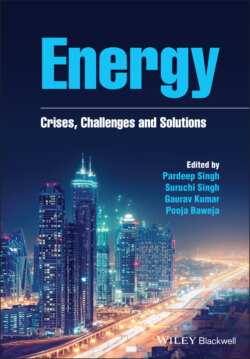Читать книгу Energy - Группа авторов - Страница 64
2.3.4.5 Enhanced Geothermal Systems (EGS)
ОглавлениеConventional geothermal plants use the heat reservoirs which are present at intermediate (0.1–4 km) or shallow (up to 0.1 km) depths (Olasolo et al. 2016). Heat content of these reservoirs is limited so to access more heat from deep geothermal reservoirs (4–5 km or more), it has been proposed that reservoirs possessing huge amount of heat can be created artificially. This technique of creating large heat reservoirs using advanced drilling technology to make artificial fractures in the deep rocks having low permeability is known as EGS (Johnston et al. 2011). Figure 2.4 depicts the basic outline of a geothermal power plant using EGS technology. EGS decreases the dependency on conventional hydrothermal reservoir along with the generation of large quantities of electricity. Hydraulic or chemical stimulation is used to create artificial fractures to make the flow of water easier through the rocks (less permeable) which are at greater depths. In the process of stimulation, water and a small amount of chemicals are injected to create or reopen fissures in the rocks that exist in greater depths. When the injection pressure decreases, there is a probability that artificial fractures in the rocks are blocked so proppants are added to avoid the closing of fractures. Binary power plants are used in the EGS technology to generate electricity using the hot brine. Since there is no natural flow of water in the deep hard rock so to exploit the heat from these hot rocks, water is used as the working fluid. To maintain the constant pressure and production, brine solution has to be re‐injected into the well, thus avoiding any release of air during the lifespan of the power plant. By the end of 2018, there were 18 important EGS sites around the globe which are harnessing electricity using the advanced drilling techniques (Lu 2018). Recently, due to advances in the area of EGS systems, some techniques are used in EGS plants to make their performance better such as use of dense fluids for hydraulic stimulation and CO2 as the working fluid.
Figure 2.4 Outline of an EGS power plant.
Source: IRENA (2017).
By making use of hydraulic stimulation, artificial fractures are created in deep and hot rock. These fractures increase permeability of the rock via increasing the natural pathways (Olasolo et al. 2016). While creating fractures in a rock, there is a high probability that this hydraulic overpressure may cause micro‐seism in the vicinity. So, use of dense fluid for hydraulic stimulation is one of the options to control overpressure at the surface. Further, use of dense fluid has many advantages such as increased and improved underground circulation pathways; less permeability of these pathways; and better mass flow ratio and heat extraction ratio (Olasolo et al. 2016).
Use of CO2 as a working fluid is more efficient at medium and high pressures while at low pressure, water is a better working fluid. Due to its high heat extraction ratio (50% higher) than water along with its better performance at low temperatures, its use as working fluid in the EGS has increased (Olasolo et al. 2016).
Many developments are taking place with respect to software packages which are used for estimating and simulating costs of the EGS plants. GEOPHIRES and EURONAT are the most suitable software packages (Olasolo et al. 2016). EURONAT is a European and GEOPHIRES is the US software package. These packages have their own pros and cons; however, GEOPHIRES has the unique feature of being capable to simulate cost for electricity generation as well as for direct use heating and combined heat and power.
Worldwide, installed capacity of geothermal can be enhanced by using some advances which increase the efficiency of operational plants. Low‐temperature bottoming cycle is one such way which increases the efficiency of power generation by making use of a binary cycle in a conventional flash power plant. Another way is co‐generation, this technique uses the heat of condensate to raise the temperature of different water source before re‐injecting into the well. To cut down cost of electricity production from the geothermal plants, use of co‐produced resources i.e. by‐product of some industrial methods as a geothermal fluid offers a viable option (IRENA 2017).
Supercritical geothermal systems are the geothermal reservoirs where fluid is present in its supercritical state i.e. at very high temperature and pressure. Use of these supercritical geothermal systems as the wells for injection can increase the efficiency of current power plant (Friðleifsson et al. 2015). Another option is establishing a plant which directly uses the supercritical systems as the heat reservoirs. These plants will have better economic performance than the traditional plant due to high‐temperature wells (IRENA 2017).
